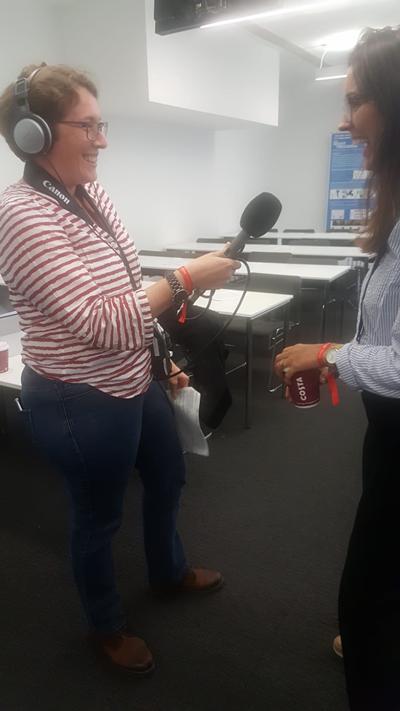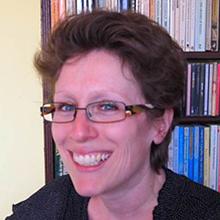Dr Lucy Green talks about her British Science Association (BSA) Media Fellowship

During the summer Dr Lucy Green, Associate Professor in Developmental Physiology, took part in the British Science Association (BSA) Media Fellowship scheme and was placed with the BBC's Science Unit. She tells us what her duties entailed, who she worked with and what she learned from the experience.
How did you get on the placement?
I saw an email about the Media Fellowship scheme from the University’s Public Engagement with Research Unit in April, and decided to apply. Well, blow me down! I was selected and placed with the BBC Science Unit, under the leadership of Deborah Cohen, MBE. Other fellowship placements were with the science desks of national newspapers, BBC Radio 2 Jeremy Vine show and BBC TV but I was delighted to get the BBC Radio placement. I have a 35 min commute to work and had become hooked on Radio 4’s Life Scientific, Inside Science and other science programmes, so this placement was exactly what I wanted.
What section did you work with? Which reporters?
In the first phase I was working in the Radio Science Unit in Old Broadcasting House and was put to work on The World Service ‘Science in Action’ programme, produced by Fiona Roberts and presented by Roland Pease. It’s a magazine-style programme covering the latest science discoveries and is aimed at a global audience. I also did some research work for the World Service ‘Health Check’ programme, produced by Paula McGrath and presented by Claudia Hammond.
In the second phase, I went across into New Broadcasting House and worked with the Science and Health online news teams. I was reporting to the Science Editor, Paul Rincon. It was a little surreal rubbing shoulders in the office with some TV and radio household names.
What was your typical day?
On the Science in Action radio show, my week would start with trawling soon-to-be-released scientific papers for suitable stories. I’d pick out a possible candidate and discuss it with the producer. Then it would be a case of researching it, and chatting to the authors and sometimes other experts for opinions, on the phone, to see how well the author spoke, and ask questions about the work. By the end of Tuesday I needed to have ‘vetted’ the potential interviewee and have set up their interview slot on the Wednesday with the programme presenter (over high quality lines or in-studio if possible). Then there was a presenter-brief to be written, and pictures and website text to be prepared. Once the interviews had been recorded, they were edited into six minute segments – I did some of this editing too. On Thursdays, it was back into the studio for the presenter to record the linking words and then by 4pm the programme would be sent off ready for the 8.30pm broadcast.
On the online science news desk, it was the same selecting stories, researching and chatting to authors and experts for quotes. Here the deadline was when the embargo was going to be lifted on the paper, and the output was my 500 word article.
What did you find most interesting about the placement?
I loved all of it but may favourite was recording the story. In September, I went with other Media Fellows to the British Science Festival in Hull. I went to press conferences with the ‘proper’ journalists who were there. I wrote up some stories, but also did some audio interviews. One of these, on soft robotic trousers to aid mobility made it through to the Science in Action programme on 20th September.

What did you find most challenging?
Juggling a microphone, notes, recorder and chatting all at the same time.
That, and suspending my desire to give all the details in written pieces… but I found it a lot easier to avoid that when writing about things I know nothing about … like colour perception in song-birds.
Has it changed your perception of the media?
I was bowled-over by the journalists I met at the BBC. They had a great passion for science and a tremendous broad knowledge-base. So that was both awesome and reassuring in equal measure.
I think I had been fearful of the ‘bloodhound’ quality often associated with journalists. But where I was placed at BBC I saw some really positive uses of these bloodhound qualities - “what’s the story?” and “why should people care?” - in turning science into broadcast and print.
Also I didn’t know much about the process of turning science into media coverage. I had a basic idea, but I have a better appreciated for it now. I’ve seen the constraints under which one sector of the media works, and learnt how I can work more effectively with them.
What was the biggest lesson you learnt during the placement?
I’ve seen how journalists are swamped with information and pressed for time. They just may not notice some of the important basic science that is taking place. And they’re even less likely to if the paper doesn’t have a press release.
Would you recommend it to others and why?
Yes. I have had an excellent few months and would highly recommend it. I’d be more than happy to chat to anyone about it – just email me.
How will this experience impact on your research and future projects?
I know a bit more about how to work more effectively with the media and it’s definitely going to make me think differently about communicating my research. Also, I have a better sense of how I might work with the media to support the advocacy and engagement work that I’m doing, in Southampton and through the Advocacy Committee of the DOHaD Society Council. The media are a valuable partner when it comes to showing the public and other stakeholders the way in which our very early developmental events will influence health across the life course and for the next generation.

